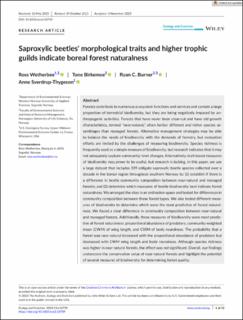| dc.description.abstract | Forests contribute to numerous ecosystem functions and services and contain a large proportion of terrestrial biodiversity, but they are being negatively impaced by anthropogenic activities. Forests that have never been clear-cut and have old growth characteristics, termed “near-natural,” often harbor different and richer species assemblages than managed forests. Alternative management strategies may be able to balance the needs of biodiversity with the demands of forestry, but evaluation efforts are limited by the challenges of measuring biodiversity. Species richness is frequently used as a simple measure of biodiversity, but research indicates that it may not adequately capture community-level changes. Alternatively, trait-based measures of biodiversity may prove to be useful, but research is lacking. In this paper, we use a large dataset that includes 339 obligate saproxylic beetle species collected over a decade in the boreal region throughout southern Norway to: (1) establish if there is a difference in beetle community composition between near-natural and managed forests; and (2) determine which measures of beetle biodiversity best indicate forest naturalness. We arranged the sites in an ordination space and tested for differences in community composition between these forest types. We also tested different measures of biodiversity to determine which were the most predictive of forest naturalness. We found a clear difference in community composition between near-natural and managed forests. Additionally, three measures of biodiversity were most predictive of forest naturalness: proportional abundance of predators, community weighted mean (CWM) of wing length, and CWM of body roundness. The probability that a forest was near-natural increased with the proportional abundance of predators but decreased with CWM wing length and body roundness. Although species richness was higher in near-natural forests, the effect was not significant. Overall, our findings underscore the conservation value of near-natural forests and highlight the potential of several measures of biodiversity for determining forest quality. | en_US |

